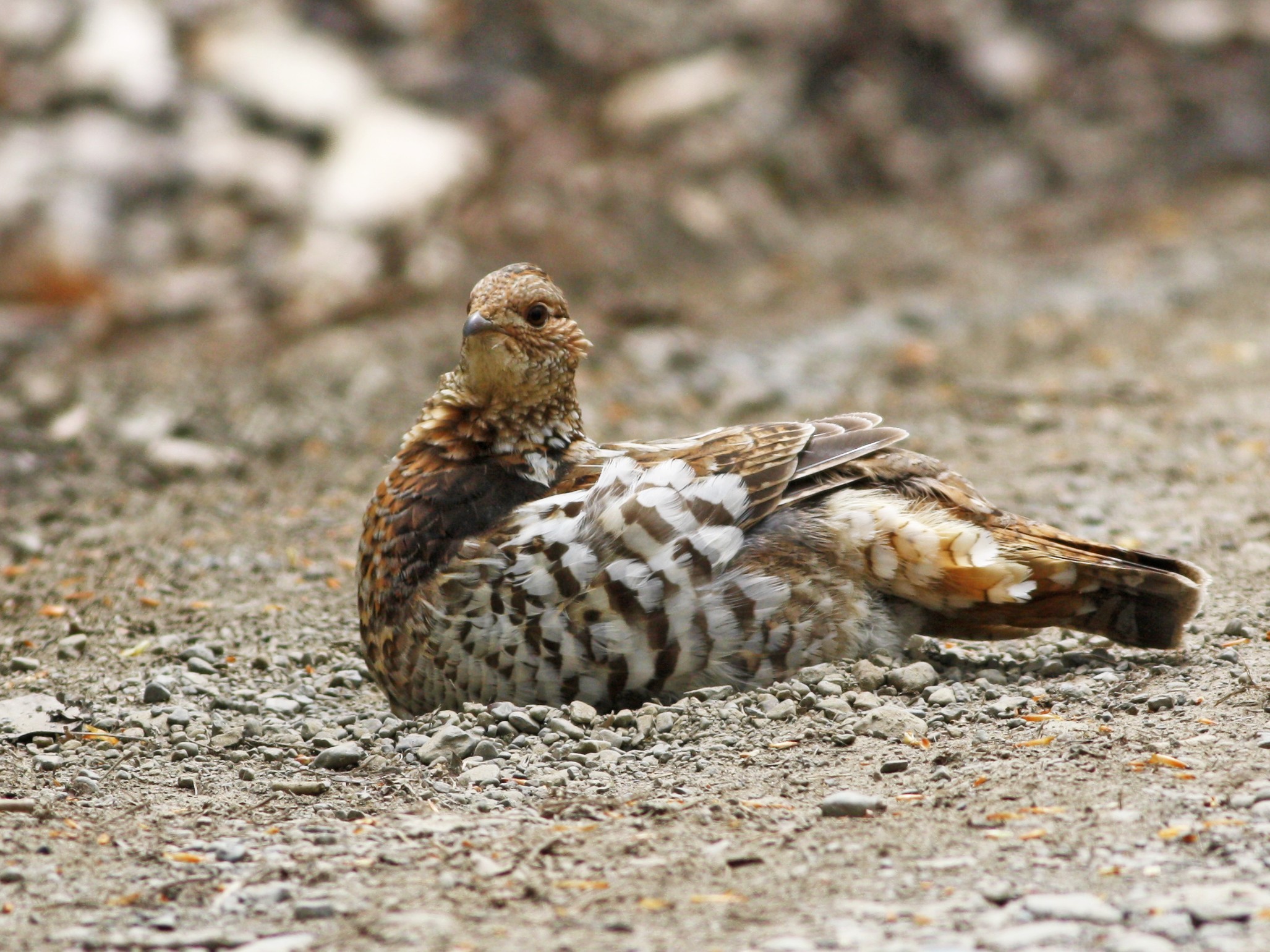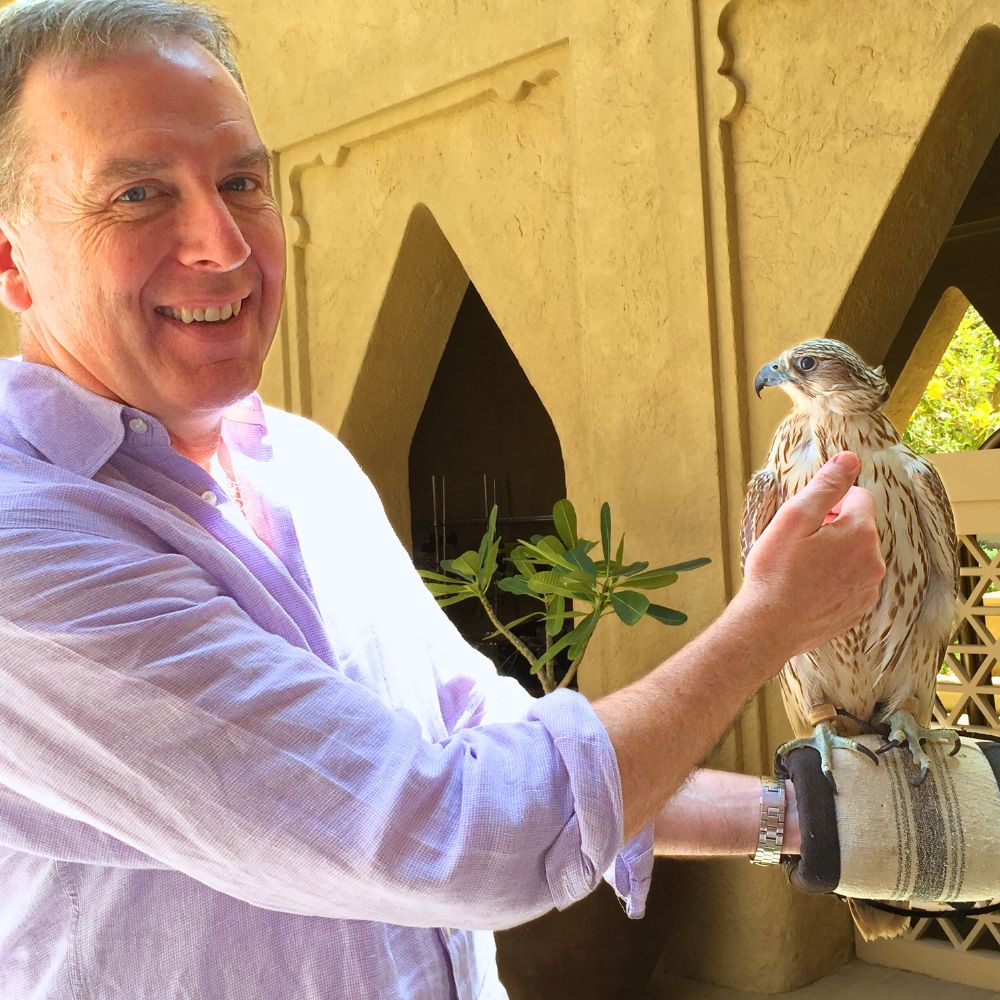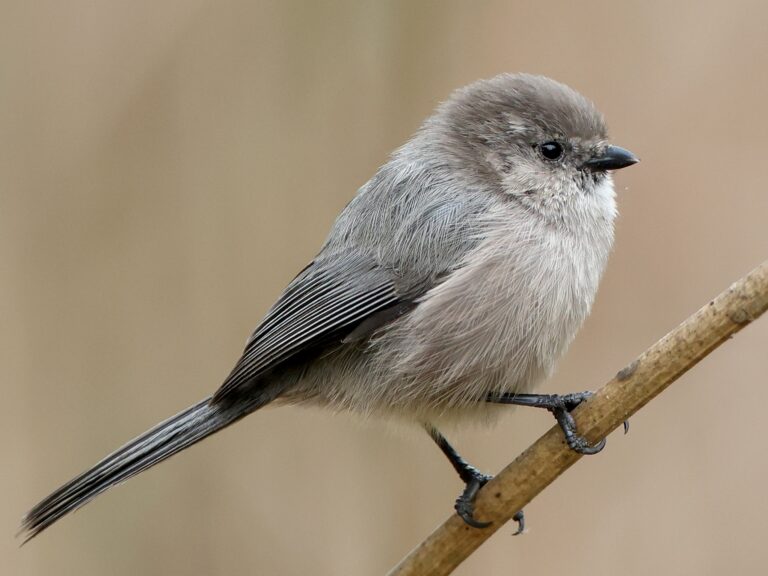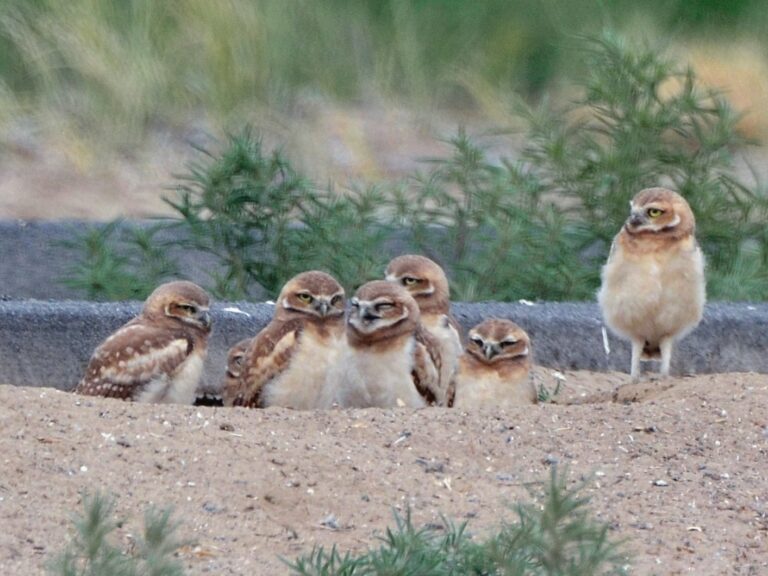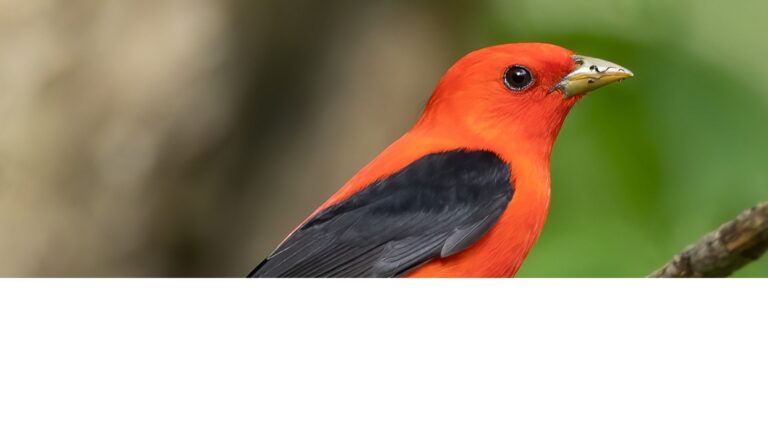The Ruffed Grouse Drumming Sound: The Science Behind Their Unique Mating Call
The ruffed grouse creates one of nature’s most distinctive sounds during springtime, including the iconic Ruffed Grouse Drumming Sound, which attracts both mates and researchers interested in its unique characteristics.
Male grouse perform their famous drumming display, known as the Ruffed Grouse Drumming Sound, by rapidly beating their wings against the air, creating a vacuum that produces a low-frequency thump.
The Ruffed Grouse Drumming Sound is crucial for establishing territory among males.
The drumming sound doesn’t come from the wings hitting a log or the bird’s body, but rather from air pressure changes caused by the acceleration of the wings themselves.
This distinctive Ruffed Grouse Drumming Sound can be heard across various habitats.
Males use the Ruffed Grouse Drumming Sound to communicate with each other as well.
The Ruffed Grouse Drumming Sound starts slowly, building in intensity to attract attention.
This Ruffed Grouse Drumming Sound serves important functions for these birds.
Many bird watchers and hunters recognize this sound from forests across North America.
Understanding the Ruffed Grouse Drumming Sound can enhance our appreciation of these creatures.
The Ruffed Grouse Drumming Sound is pivotal in their social interactions.
Choosing the right drumming site enhances the Ruffed Grouse Drumming Sound’s effectiveness.
The male ruffed grouse typically stands on a fallen log or slightly raised platform when drumming.
The sound starts slowly and builds to a crescendo, with wing beats so fast they’re almost impossible to see with the naked eye.
This drumming behavior serves important functions in territorial defense and attracting female grouse during mating season.
Scientists have studied this fascinating behavior extensively, yet some aspects of the drumming sound continue to intrigue researchers.
The Ruffed Grouse Drumming Sound is not only fascinating but also plays a critical role in the life of these birds.
The acoustics of the Ruffed Grouse Drumming Sound carry surprisingly far through forest environments, allowing males to communicate their presence to both potential mates and rival males without visual contact.
These drumming sites are carefully selected by males and often used year after year if undisturbed.
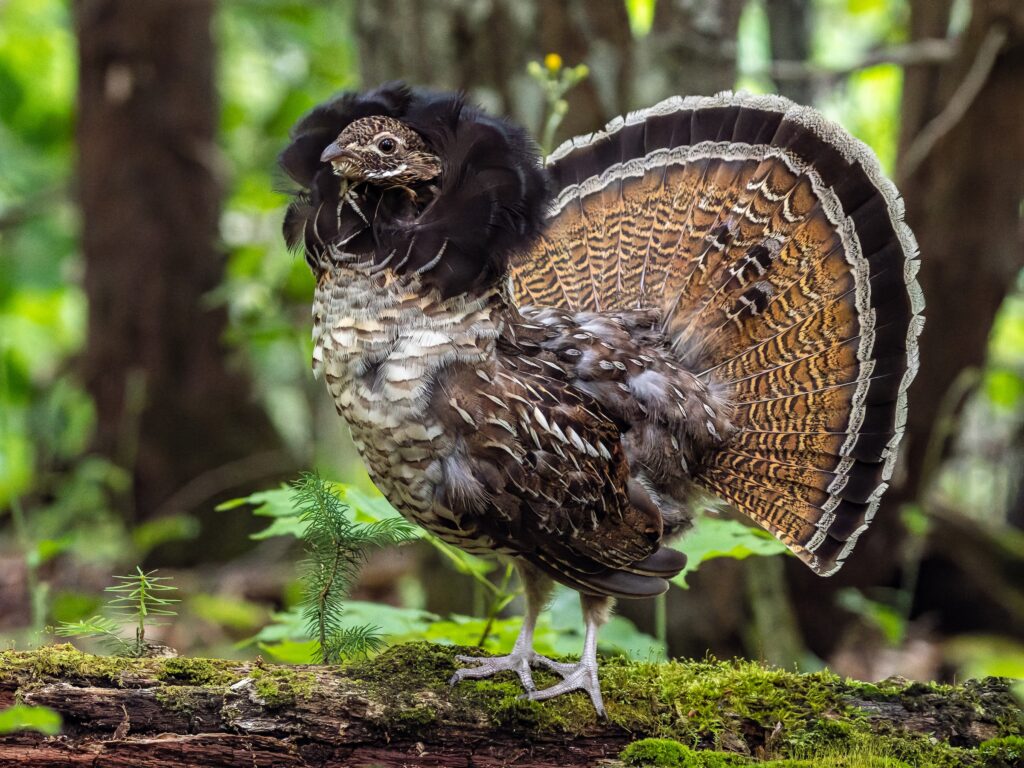
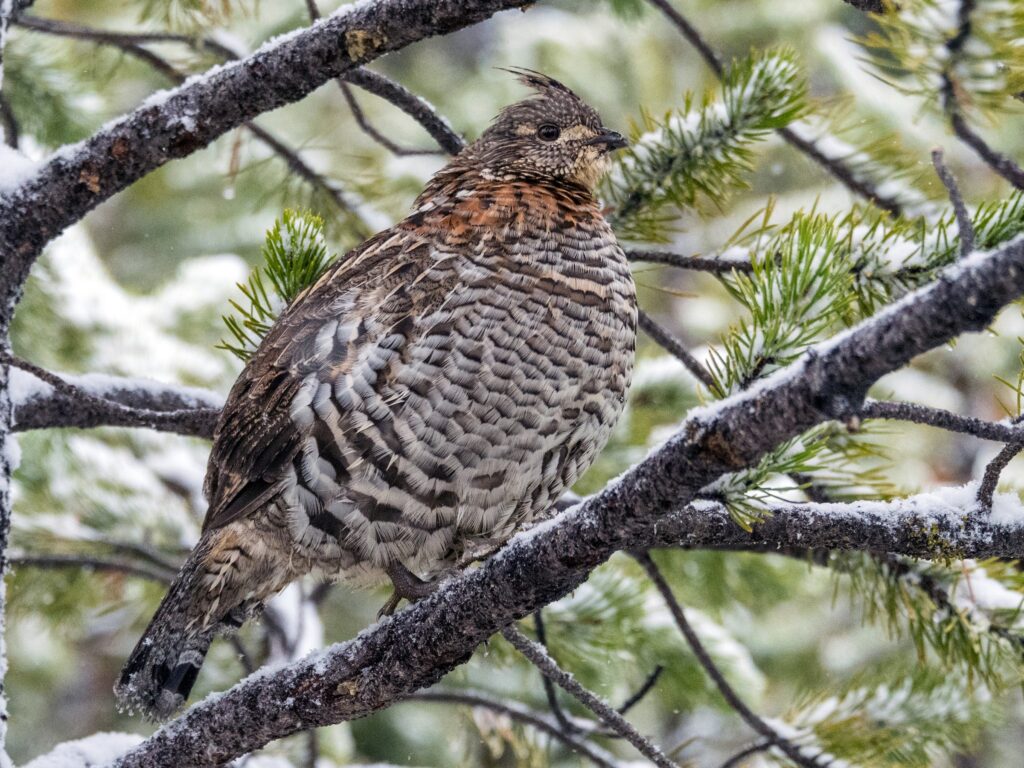
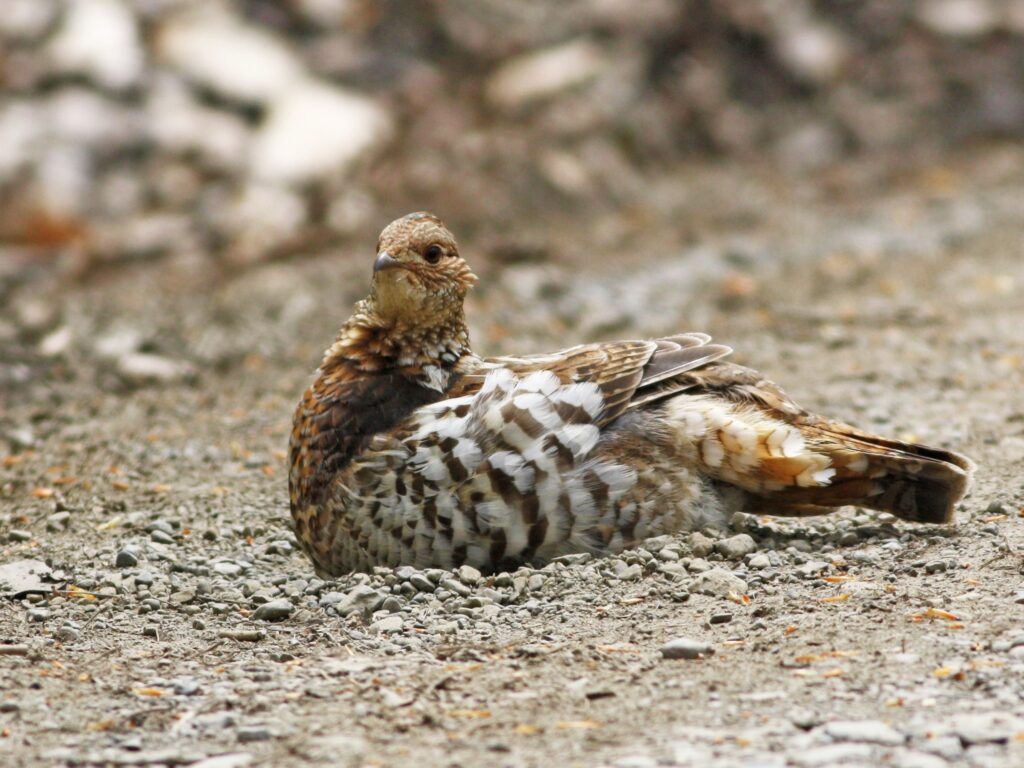
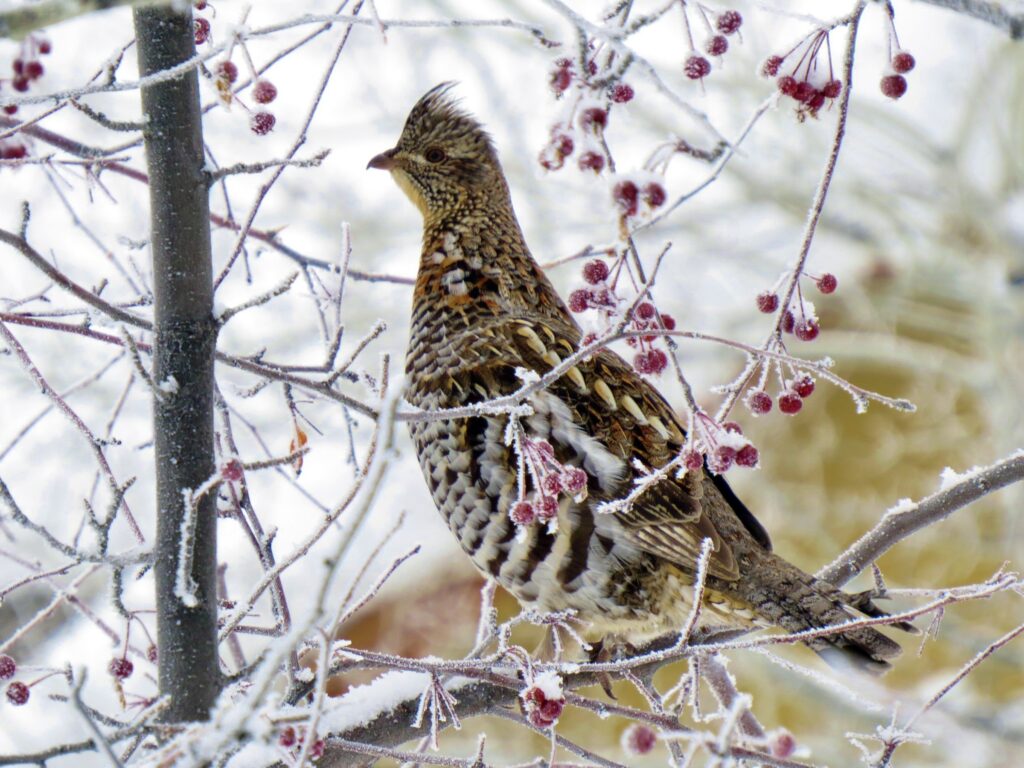
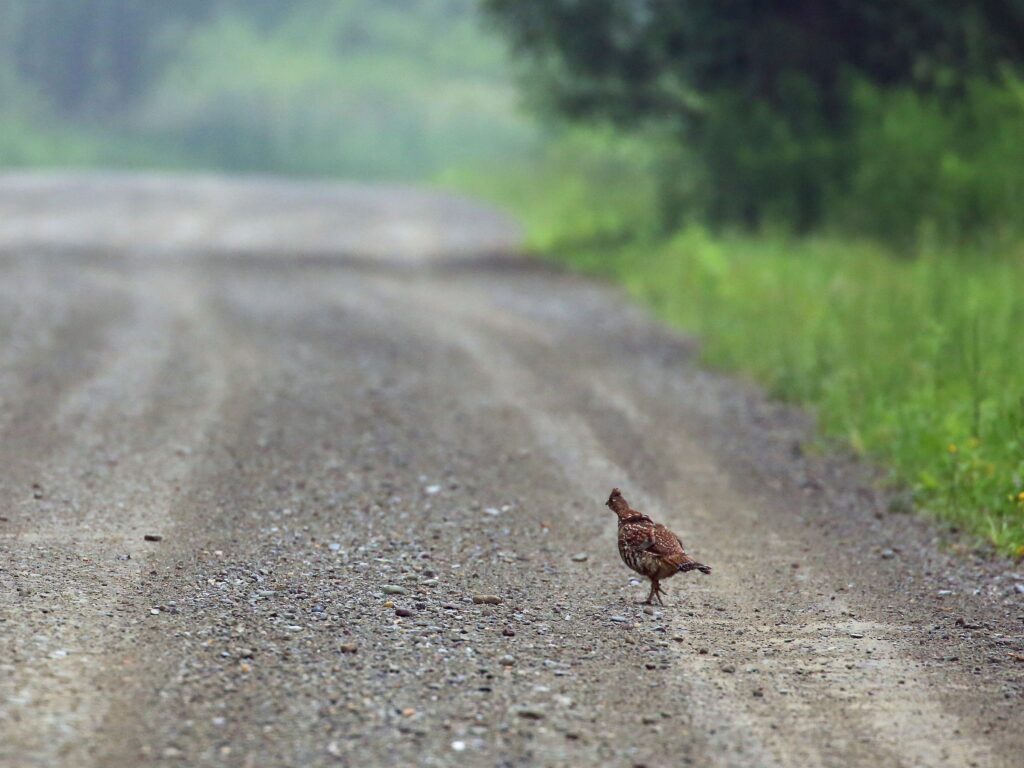
Key Takeaways
- Ruffed grouse create their drumming sound through rapid wing beats that cause air pressure changes, not by hitting their bodies or logs.
- Male grouse use drumming primarily for attracting mates and defending territory during the spring breeding season.
- Each male selects specific drumming sites that provide both acoustic advantages and protection from predators.
Understanding the Ruffed Grouse
Ruffed grouse are remarkable woodland birds with specialized adaptations that help them survive in forest environments.
Their unique physical traits and specific habitat requirements contribute to both their survival and their famous drumming behavior.
Physical Characteristics
The ruffed grouse (Bonasa umbellus) is a medium-sized game bird with a stocky build, weighing between 17-25 ounces.
Its most distinctive feature is the dark neck ruff of feathers that males fan out during courtship displays and drumming.
Both sexes display two color phases: reddish-brown and grayish, with intricate barring patterns on their bodies.
These birds have excellent cryptic coloration that blends perfectly with forest floors.
Their mottled brown, black, and gray plumage provides effective camouflage against predators.
Ruffed grouse have short, rounded wings adapted for quick, powerful bursts of flight through dense woodland.
The birds’ tails feature a distinctive dark band near the tip. Males have slightly longer tail feathers, which play a vital role in their drumming displays.
Their strong legs allow them to walk and run efficiently through woodland undergrowth.
Habitat and Distribution
Ruffed grouse thrive in young forests with dense understory vegetation and scattered clearings.
They prefer mixed woodlands containing aspen, birch, and conifers that provide both food and cover.
These territorial birds typically occupy 6-10 acre ranges, with males defending prime drumming sites.
Their range spans much of North America, from Alaska across Canada and throughout the northern United States.
They extend south along the Appalachian Mountains and into isolated pockets of suitable habitat in western mountains.
Grouse require different forest types throughout the year.
In winter, they seek dense conifer stands for thermal protection. Spring brings them to open hardwood areas with logs for drumming sites. Summer habitat includes areas with abundant insects for young chicks.
Young forest regeneration after logging or natural disturbances creates ideal grouse habitat with the mix of cover and food sources these birds need to thrive.
The Mysteries of the Drumming Sound
The male ruffed grouse produces a fascinating drumming sound that has long intrigued naturalists and hunters alike. This unique sound travels through woodland areas and serves specific biological purposes while employing specialized physical mechanisms.
Anatomy of the Sound Production
The drumming sound isn’t made by the grouse hitting a log with its beak as some might assume.
Instead, the male bird creates this sound through rapid wing movements.
The male positions himself on a raised platform such as a fallen log, stump, or rock.
The sound is produced when the male bird beats his wings forward and upward.
Each wingbeat creates a vacuum when the wings are pulled back against the body, generating a low-frequency thundering sound wave.
Understanding the Ruffed Grouse Drumming Sound
The Ruffed Grouse Drumming Sound is a key element of their behavior, and understanding this phenomenon provides insights into their communication and mating rituals.
Each Ruffed Grouse Drumming Sound is a unique display of the male’s fitness.
This action happens incredibly quickly—starting slowly but accelerating to a blur of motion.
The bird’s specialized feather structure and muscle control enable this precise movement.
The wings never touch the log or each other; rather, the compression of air creates the distinctive thump.
Understanding the intricacies of the Ruffed Grouse Drumming Sound can aid in conservation efforts.
Listening for the Ruffed Grouse Drumming Sound is a popular activity among bird watchers.
Role in Courtship and Mating
The Ruffed Grouse Drumming Sound can carry over vast distances in the forest.
Females respond to the Ruffed Grouse Drumming Sound as a signal of male availability.
Drumming serves as a primary communication method for male ruffed grouse during mating season.
This behavior typically peaks in spring when males establish territories and attempt to attract females.
The sound can travel up to a quarter-mile through the forest, acting as both a territorial declaration to other males and an advertisement to potential mates.
The response to the Ruffed Grouse Drumming Sound can influence mating success.
Each male typically claims a specific drumming log that he returns to repeatedly.
Females are drawn to the drumming sound and visit males at their display sites.
A deep understanding of the Ruffed Grouse Drumming Sound can enhance wildlife management practices.
Monitoring the Ruffed Grouse Drumming Sound is essential for understanding population dynamics.
The quality and frequency of drumming may help females assess male fitness and vigor.
Males often increase their drumming activity at dawn and dusk when the woodland sounds carry farthest.
Some males will drum hundreds of times daily during peak courtship periods, demonstrating remarkable stamina and dedication to this energy-intensive display.
Ecology and Behavior
The drumming behavior of ruffed grouse plays a crucial role in their survival and reproductive success. These adaptations have evolved over time to help the species thrive in woodland habitats across North America.
Territorial Claims and Predation
Male ruffed grouse select specific drumming locations with high total stem density that provide both visibility and protection.
These drumming sites are carefully chosen to maximize sound propagation while minimizing exposure to predators.
When a male establishes a territory, he defends it vigorously against other males through his drumming displays.
This territorial behavior can sometimes escalate to physical confrontations when drumming alone fails to deter intruders.
The grouse’s mottled brown and black plumage provides excellent camouflage against forest floors, helping them avoid detection by predators such as foxes, hawks, and owls.
Their ability to blend into surroundings is essential for survival.
Intensive searches across various cover types reveal that grouse select habitat with specific characteristics that balance their need to be heard while staying protected from predation.
Reproductive Cycle and Incubating Chicks
The drumming behavior intensifies during the spring mating season when males are attempting to attract females.
After successful mating, the female assumes all responsibility for incubating the eggs and raising the young.
Female grouse typically lay 8-14 eggs in ground nests concealed by vegetation.
The incubating period lasts approximately 23-24 days, during which the female leaves the nest only briefly to feed.
Once hatched, the chicks are precocial, meaning they can leave the nest and follow their mother within hours of hatching.
She teaches them to find food while providing protection from predators.
Young grouse develop rapidly, learning to make short flights within 10-12 days.
The mother continues to protect her brood until they disperse in late summer, typically when they reach about 12 weeks of age.
Ruffed Grouse Conservation and Hunting
Ruffed grouse populations depend on proper habitat management and sustainable hunting practices. Conservation efforts focus on maintaining young forest habitats, while hunting regulations help ensure population stability.
Habitat Management
Ruffed grouse thrive in young forests with dense understory vegetation.
The Ruffed Grouse Drumming Sound plays a significant role in their ecological interactions.
These birds need a mix of habitat types including drumming sites for males and nesting areas for females.
Early successional forests—those 5-15 years after disturbance—provide ideal cover and food sources.
Forest management practices like small clear-cuts, selective logging, and prescribed burns create the patchy habitat grouse need.
Conservation organizations work with landowners to implement these practices on private lands.
Studies in Maine and other regions show that proper habitat management is crucial for maintaining healthy grouse populations.
Without active management, forests mature and become less suitable for grouse.
Wildlife managers use drumming surveys to monitor population trends, helping inform conservation decisions and habitat improvement projects.
Ethical Hunting Practices
Ruffed grouse are popular game birds, often called the “woodland drummer” by hunters.
Hunting seasons typically run from early fall through winter, with specific dates varying by state or province.
Ethical hunters follow these key practices:
- Respect bag limits and hunting regulations
- Identify targets before shooting
- Retrieve all harvested birds
- Report hunting data when requested
Hunting regulations are designed based on population assessments and help ensure sustainable harvest levels.
Understanding when and how males produce the Ruffed Grouse Drumming Sound enhances our knowledge of their behavior.
Most areas allow 2-5 grouse per day, though limits vary by location.
Further research into the Ruffed Grouse Drumming Sound can reveal much about their communication strategies.
Hunter education programs teach conservation principles alongside hunting skills.
The Ruffed Grouse Drumming Sound’s significance goes beyond mere attraction; it contributes to a complex social structure.
The drumming sound also serves to ward off competitors, establishing the male’s dominance.
As a unique ruffed grouse drumming display, the sound fascinates nature enthusiasts everywhere.
Many hunters actively participate in habitat improvement projects, recognizing their role in conservation.
Female grouse receive special consideration in some areas through shortened seasons or reduced bag limits during nesting periods to protect breeding populations.
Frequently Asked Questions
The ruffed grouse produces its distinctive drumming sound through a unique physical process involving rapid wing beats. This behavior serves important biological functions, especially during specific seasons and times of day.
What causes the drumming sound produced by ruffed grouse?
The drumming sound comes from the male ruffed grouse rapidly beating its wings against the air.
Unlike what many people assume, the sound is not created by the wings hitting a log or the bird’s body.
The male grouse stands on a drumming log or raised platform while beating its wings. The wings create a vacuum when they meet in front of the body, and the resulting compression of air produces the characteristic drumming sound.
This sound starts slowly and increases in speed, creating a thumping that resembles a distant motor starting up.
When are ruffed grouse most likely to perform their drumming?
Ruffed grouse primarily drum during the spring breeding season, typically from late March through May.
This timing coincides with their mating period when males are establishing territories.
Studies on ruffed grouse drumming behavior show that drumming activity peaks in April in most regions.
Males may continue some drumming into early summer, though with decreasing frequency.
During peak season, a male grouse might drum dozens of times each day, especially during morning hours.
What is the significance of drumming behavior in ruffled grouse?
Drumming serves multiple purposes in ruffed grouse social behavior. The primary function is to attract females for mating during breeding season.
Many birders travel great distances to hear the Ruffed Grouse Drumming Sound in its natural setting.
The Ruffed Grouse Drumming Sound is a distinctive aspect of their courtship rituals that captivates observers.
Hearing the Ruffed Grouse Drumming Sound in the wild is a thrilling experience for nature lovers.
Males also use drumming to establish and defend their territory from other males.
The sound travels effectively through woodland environments, allowing males to communicate their presence without direct confrontation.
Research indicates that the non-vocal drumming display helps females locate suitable mates and helps males space themselves through the forest.
Do female ruffed grouse also engage in drumming?
Female ruffed grouse typically do not drum. Drumming is a sex-specific behavior performed almost exclusively by male birds.
Females spend their energy on nest-building, egg-laying, and caring for young rather than territorial displays.
They respond to male drumming by approaching the sound if they are receptive to mating.
This gender difference in behavior is consistent with many bird species where males perform displays to attract mates.
Can the drumming sound of a ruffed grouse be mistaken for another bird?
The ruffed grouse’s drumming sound is quite distinctive and unlikely to be confused with other bird calls or songs.
However, people unfamiliar with it might mistake it for a distant motor or machinery.
Some have compared the sound to an old tractor starting up or a distant drum.
The woodland drummer’s sound travels well through forests.
The increasing tempo of the wing beats creates a unique pattern that wildlife enthusiasts can learn to recognize reliably.
At what times of day are ruffed grouse known to drum?
Ruffed grouse typically drum most actively during early morning hours, often starting before sunrise.
A second period of increased drumming activity often occurs in the late afternoon and early evening.
Research on spring drumming patterns shows that individual birds may have different daily rhythms, but dawn remains the peak time for most males.
Weather conditions also influence drumming times, with birds being more active on clear, calm days and less active during heavy rain or strong winds.
